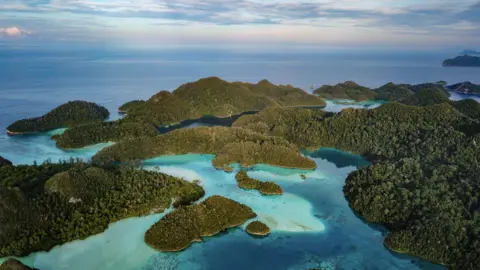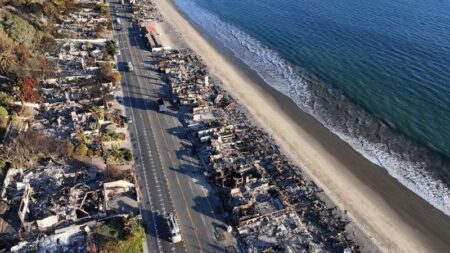The race to mine metals essential for electric vehicle (EV) batteries is posing significant threats to the marine paradise known as the Raja Ampat archipelago in Indonesia. Captured from a drone by environmental activists and shared widely, stark images reveal the alarming effects of intensive nickel mining on one of the world’s most biodiverse marine habitats. Raja Ampat, often referred to as the “Amazon of the Seas”, has seen a dramatic increase in mining activity fueled by the growing demand for nickel, a critical component used in not only EV batteries but also in stainless steel production.
In a recent development welcomed by environmental advocates, the Indonesian government announced the revocation of permits for four out of five mining companies operating in Raja Ampat. This decision was motivated by the urgent need to protect the area’s unique biodiversity, which is considered a global heritage site. Indonesia’s Ministry for the Environment articulated its commitment to safeguarding Raja Ampat’s rich natural resources, highlighting that actions would be taken to address existing mining impacts.
However, photographs from organizations like Global Witness indicate that the damage has already been done. The aerial images captured during investigations depict deforested areas and sediment runoff contaminating the waters that are crucial habitats for coral reefs. Specifically, Global Witness documented a 500-hectare increase in land used for mining between 2020 and 2024, roughly the size of 700 football fields. This expansion signifies a worrying trend, as such operations often lead to irreversible environmental degradation.
In addition to the immediate ecological damage, the government’s decision to revoke mining permits may face challenges from legal actions initiated by the companies in question. Furthermore, while the government’s actions received praise, one mining operation on Gag Island—known for its rich nickel deposits—continues to operate without interruption, raising concerns that the protective measures might not be uniformly enforced.
Dr. Mark Erdmann, a coral reef conservationist and ecologist who has dedicated more than two decades to research in Raja Ampat, expressed his elation over the government’s decision. His advocacy has often been driven by public outcry, emphasizing how citizen activism can influence policy in Indonesia. Nonetheless, he cautions that the increasing global demand for battery metals poses a continuous threat to the region’s fragile ecosystems.
The importance of the Raja Ampat ecosystem extends beyond its aesthetic appeal; it is a critical habitat for numerous marine species and a prime destination for divers and eco-tourists. However, the pressure exerted by mining operations illustrates a broader dilemma—the increasing need for essential minerals to support the transition to greener technologies like electric vehicles. While the shift to clean energy is paramount, it can inadvertently lead to environmental destruction if not managed with foresight and rigor.
Reports indicate that Indonesia currently holds over half of the world’s nickel production, a statistic that reflects the country’s intensified engagement in the global lithium-ion battery supply chain. Nevertheless, outside Raja Ampat, mining has been linked to broader environmental issues in the region, as demonstrated by a 2024 study from Forest Watch Indonesia, which tied mining-related deforestation to escalating local flooding and landslides.
The situation is undeniably complex. Experts such as Dr. Michaela Lo Ying, who examined the effects of mining on communities in Sulawesi, highlight that while mining can slightly alleviate poverty, it simultaneously exacerbates environmental decline and pollution. As nations grapple with the need for sustainable development in tandem with ecological preservation, the question remains: at what cost does the transition to renewable energy come? Dr. Erdmann articulately sums up the problem: finding equilibrium between economic aspirations and environmental stewardship is crucial as Indonesia navigates its role in the global nickel market.
As we consider the ramifications of nickel mining in Raja Ampat, it is essential to recognize that urgent actions are needed not just to halt the destruction but also to ensure comprehensive restoration of ecological balances that have already been disrupted. The intertwining of environmental sustainability and resource demand must inform future policies aimed at protecting valuable ecosystems while addressing the energy transition.











